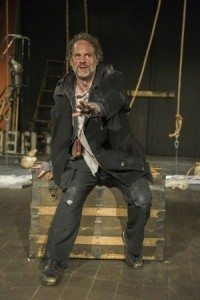

Directing a play is always a challenge, so directing two at the same time is definitely demanding (especially if you’re doing your own sound design). That’s what Rick Lombardo pulled off this season, directing Albatross at 59E59 Theaters and Ring Twice for Miranda at New York City Center at the same time.
Albatross is a one-man show adapted from Samuel Coleridge’s poem “The Rime of the Ancient Mariner,” while Ring Twice for Miranda follows the struggles of a housemaid and a butler living in a dystopian society. Rick Lombardo talked to us about the challenges and successes of helming two such different plays simultaneously.
These two shows are so different from each other in a lot of ways. What was it like approaching them both at the same time?
It was a whirlwind, I’ll say that. You’re right, they are two very different shows, which I enjoyed. Doing wildly different things is very exciting to me. One of the reasons that it was even possible is because the Albatross project is one that I’ve been working on for about two years now. We did the first production in Boston back in the winter of 2015, almost exactly two years ago this month. We’ve done several other productions, in America and in Edinburgh, Scotland over the summer. It’s always been with Ben Evett performing it, and he’s also one of the co-writers. Albatross has turned out to be a project that’s relatively simple for us to move into a venue and get it up and running again. If I had really been starting on two projects simultaneously from scratch, that would’ve been absolutely impossible.

The most noticeable difference between the two is that Albatross is a one-man show, and Ring Twice for Miranda has a full cast. How does your process differ for those two formats?
Well, I love working with large acting companies. I really love actors, and I love the energy of having all those artists in the room and seeing all the ideas being generated, so that’s always really exciting. But at the same time, the one-man show, the actor Ben Evett and I have a very deep, long relationship, both personally as friends and as artists. I think I directed Ben over the last sixteen years in something like eight to ten projects. I directed him in Hamlet a few years back, and in many other things. So we have a shorthand. We have a way of working with each other that’s very easy, and we’re also very good friends. That’s just a different process. When you’re in the room working with an artist that you know very intimately and they know you very intimately, you can get a lot done in rehearsal really fast, since you’re not trying to figure each other out. With Miranda, I had never worked with any of these actors before we started, so it’s not only the process of let’s explore and discover the play together, it’s let’s explore and discover each other and who we are as artists, how we’re going to work together on this piece. I think every actor that I work with, I have a different relationship with.
Were there any similarities between the two shows?
They’re so different. One of the similarities is that I also did the sound design for both shows, because as a director I am a sound designer and I love to do sound design for certain project. But even in that respect, the sound design for Albatross is wildly different than for Miranda. Albatross is almost a complete cinematic soundtrack, a score if you will, and almost the entire piece is underscored. Whereas Miranda is much more sparse because it’s a tighter world. In many ways they don’t have a lot of similarities, they’re quite different.
I did notice that you did the sound design for both! What’s it like to approach that alongside directing?
Before I went into the theater, I was also a musician, so sound and music are very powerful to me and very evocative. As a director, about half the time I direct the show I also do my own sound design, unless it’s something where I really want to bring another person in to bring a unique perspective that I don’t have. I find, for me as an artist, it’s a way that I complete the picture that I’m working on directorially. In a sense, it’s almost like a film director who works on some of their own editing. I find that working on the sound helps me with the shape and the vision of what the final production is going to look like as well. With Albatross specifically, because of the multi-media aspect of it, sound and music and imagery needed to work kind of as a machine. I started creating the sound design in the rehearsal room, testing them out and exploring it with Ben so that we were developing it very organically.

Did your experience with one of the plays impact how you saw the other?
Both plays, deep down, ask some similar questions. Both plays ask: what does it mean to be human? What is our responsibility to each other? Obviously, Miranda is in a dystopian world, so that’s a really different situation. Albatross explores our responsibility to nature and the natural world. But deep down there’s a shared sense of values of what it means to be human.
These stories are so different. What drew you to them, and what are you trying to express, either through both of them or separately?
I really believe in the messages of both of the plays. With Albatross, the deep question of what is our responsibility to the natural world, what is our responsibility to all creatures, large and small. In a world right now where climate change is rapidly threatening not only us, but many creatures and sea creatures. And in a world right now where we have climate change deniers. How we need to take care of our oceans is vitally important to me, so I’m deeply passionate about the message of Albatross. At the same time, in Miranda, with this exploration of the tyranny of power, and the exploration of the potential fallout of having a -- how do I say this -- delusional narcissistic leader, and the type of world and the dystopia that could result from that, and the loss of personal freedom that can come from that, I think that Miranda speaks very deeply to me on those issues.
Performances of Albatross continue through February 12 at 59E59 Theaters. Performances of Ring Twice for Miranda continue through April 16 at New York City Center Stage II.